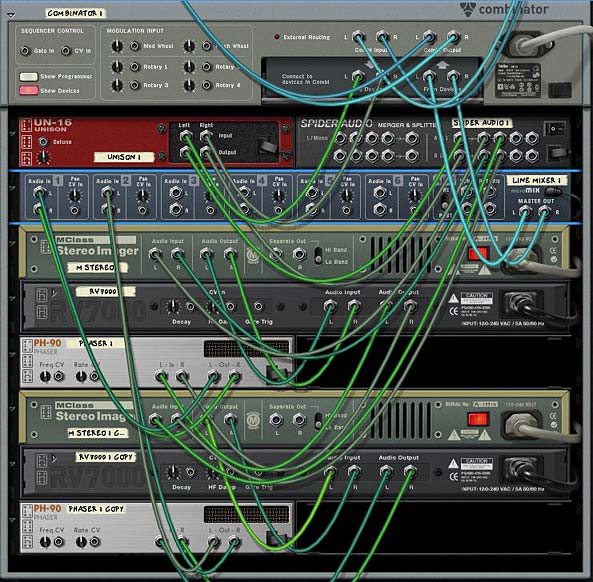Kevin Parks (aka: “Liquid Silver,” “Wyatt,” or “Ambient Synthesis”)
June 8, 1949 – April 28, 2010
I am writing for Kevin to let you know his trip to Mexico was unsuccessful. He died April 28, 2010. Your friendship and sharing with him added so much to his life these past two years. He enjoyed his friends in music to such a degree that he hardly had time to notice how ill he was. Thank you, thank you.
– Louise Parks

That was the email that hit my inbox last week and though I never met Kevin, we had some wonderful online conversations, discussions about music, discussions about Reason. He sent me a song whenever he could; usually more than I had the time to really get into and play with. And we shared in some wonderful one-on-one collaborations. I kept telling myself if only there were more time and if only I was less busy. But in the end honestly we make our choices in how we spend our time, and I regret not having more time to devote to our friendship and nurturing our collaborations. You see, we never finished anything together. We had a lot of back and forth musically, and we lended each other a lot of ideas over the past 2 years, but everything we did was unfinished. Such is the way life can be.
We first met due to a mutual interest in Photoshop and graphic design. From there it was a short leap to find our mutual interest in music. He was mainly using Adobe Audition for his audio, and I helped teach him some of the fundamentals of using Reason and midi. He taught me some of the finer points of audio processing. He was also the first to contribute an article to my blog all about panning and getting your mix right. A good read which I highly recommend: http://www.reason101.net/contributions/panning-to-punch-out-your-mix/
I am very fortunate we had the friendship we did. Without him, you wouldn’t be reading this blog at all. This site would never have existed. It was in part his prodding and the fact that he was my first beta tester for a lot of my combinators. Without him, I probably never would have started this at all. So I owe him a great debt of gratitude. He was such a good musical friend. And when I got too deep into making combinators or designing sounds, he was always there to help out and he would always tell me to never forget about actually making music. That’s the kind of guy I knew him to be. Practical, honest, and always trying to improve himself through his music.
Letting the Work speak for the Man
It’s hard for me to find the right words. Usually most people will say the usual: he was kind. He was a great guy. He was always there when you needed help. With Kevin that was all true. Any question I would ask, he would always be there to respond. Anytime you needed help he was the guy you wanted helping you. In truth I can’t say enough good things about him.
It’s with great sorrow that I have to inform everyone of his passing. I hate letting go of the good people in life; the selfless souls that are kind to the core. I can only hope that he’s up there teaching a few angels how to play some really great music on his Fender Strat!
The following is an unfinished piece which Kevin sent to me. I’d like to share it with everyone as it is. It is 100% Kevin’s, and completely unaltered. It was the last piece of music he sent me. At the time, he was trying his hand at something atmospheric and ambient. I think this work is simple understated brilliance:
Symbionic: [ti_audio media=”486″]
And this is a piece he put together last July which shows a glimpse of his guitar work:
Blue July: [ti_audio media=”487″]
This is a video he put together for one of my songs. As I said, he was a great guy and was always there when you needed a helping hand. Since we both had a love for Photography and Photoshop, he wanted to try his hand putting together a video for me. I was so grateful when he did:
Here are a few links to some of Kevin’s work and online locations, if you are interested and would like to learn more about him:
http://www.motagator.net/Liquid_Silver//User_520.php
http://www.youtube.com/user/AmbientSynthesis
http://www.soundclick.com/bands/default.cfm?bandID=524961
And here is a quote from Kevin which can be found on http://www.yourbestsound.com/InaSpin/files/ExtraSpin.pdf :
Music means more to me now than ever before. I started music lessons in 1957 …first performed at the Worlds Fair, NYC, 1960. Did get tired of playing Debussy on clarinet, though. Then I discovered guitar!
Guitar was my constant companion through the 60’s and 70’s …playing in numerous acoustic groups, played a lot of parties, lots of late night jam sessions, and sidewalk-guitar. In the 80’s I played regularly for my church and taught guitar and songwriting.
I once had the privilege of knowing Broadway Musical Director, Stanley Lebowski, who many years ago said that he thought I had a germ of talent. I wish he were still around to see what I did with it.
Currently, I spend enormous amounts of time in my studio, searching out elusive sounds on guitars, harmonicas, keyboard, and congas. Retirement just doesn’t get better than this.
Rest in peace my friend. We’ll all miss you greatly.

